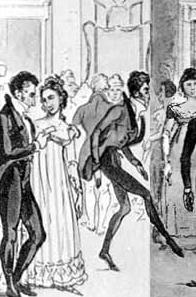- Historical Dance
- Jazz Age Social Dancing ("The Modern Dances")
- Ragtime Dance - the One Step
- Regency Dance
- "Mr Nelson's System of Simplified Regency Dance"
- An Analysis of Country Dancing - 1808
- Cotillions and Country Dances 1792
- Elements of the Art of Dancing - 1822
- The Complete System of English Country Dancing - 1815
- The Scholar's Companion - Cotillions and Country Dances - 1796
- Thos Wilson's Quadrille Instructor - Ca 1816
- Thos. Wilson's Description of Regency Waltzing - 1816
- Treasures of Terpsichore - 1816
- Victorian Dance
2. The Country Dance
"The characteristic of an English country dance is that of gay simplicity. The steps should be few and easy, and the corresponding motion of the arms and body unaffected, modest , and graceful". – The Mirror of Graces, 1811
 In Mr. Thomas Wilson's lengthy and detailed treatise on the English Country Dance ("The Complete System of English Country Dancing"), he goes into excruciating detail on all the possible figures of the dance all based on one mathematical assumption: that they are in even numbered tempi (2-4, 4-4 etc time). In other works, he does include base-3 dances as "Country Dances", but the dance patterns in "The Complete System..." only work with even numbered tempi. This is the area where I will focus my "Country Dance" step patterns.
In Mr. Thomas Wilson's lengthy and detailed treatise on the English Country Dance ("The Complete System of English Country Dancing"), he goes into excruciating detail on all the possible figures of the dance all based on one mathematical assumption: that they are in even numbered tempi (2-4, 4-4 etc time). In other works, he does include base-3 dances as "Country Dances", but the dance patterns in "The Complete System..." only work with even numbered tempi. This is the area where I will focus my "Country Dance" step patterns.
Many dances in three-four time are older dances (Mr. Beveredge's Maggot, Well Hall, Hole in the Wall), such as might have been danced by Jane Austen's parents or grandparents, or they are Regency era figure waltzes, but they won't work with the base four step pattern.
So, here below I will lay out the basic steps of the even tempi country dance, and lay out the steps of the three-four Minuet/Waltz time dances in the section titled Bourée dances (3-4 Time) "
